
The Cyperaceae are a family of graminoid (grass-like), monocotyledonous flowering plants known as sedges. The family is large; botanists have described some 5,500 known species in about 90 genera – the largest being the "true sedges", with over 2,000 species.
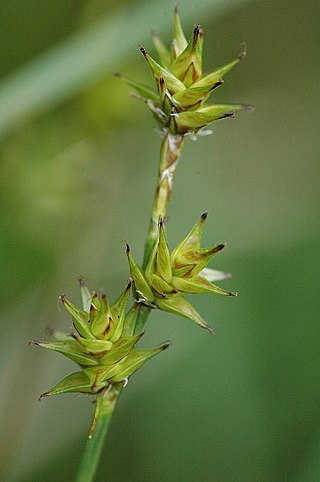
Carex echinata is a species of sedge known by the common names star sedge and little prickly sedge.

Dulichium is a monotypic genus of sedge containing the single species Dulichium arundinaceum, which is known by the common name threeway sedge. This is an aquatic or semi-aquatic plant of the lakes, streams, and ponds of the United States and Canada. It has a wide distribution across the two countries, though noticeably absent from the Dakotas and from the Southwestern Deserts.

Carex cusickii is a type of grass-like plant in the family Cyperaceae. It is native to Northwestern North America from British Columbia to California, and in Utah, where it can be found in several types of wetland habitat, such as marshes, mountain meadows, and ditches. In its range it is most common in the Cascade Range and areas west.

Carex binervis, the green-ribbed sedge, is a European species of sedge with an Atlantic distribution. It is found from Fennoscandia to the Iberian Peninsula, and occurs in heaths, moorland and other damp, acidic environments. It typically grows to a height of 15–120 cm (6–50 in), and has inflorescences comprising one male and several female spikes, each up to 45 mm (1.8 in) long. The utricles have two conspicuous green veins, which give rise to both the scientific name and the common name of the species. In the vegetative state, it closely resembles C. bigelowii, a species that usually grows at higher altitude. C. binervis was first described by James Edward Smith in 1800, and is classified in Carex sect. Spirostachyae; several hybrids with other Carex species are known.

Carex distans, commonly known as distant sedge, is a plant species in the sedge family, Cyperaceae. It is native to Europe and North Africa. It is part of a complex of similar species that occur across Eurasia. Its relatives include Carex diluta of central Asia, which has also been introduced to North America in Montana. Carex distans has been introduced to US states including Maryland and Pennsylvania. More recently, it was found in Oregon. There is a report from Victoria, Australia as well.
Carex tereticaulis, also known as basket sedge, is a species of sedge of the family Cyperaceae that is native to southern parts of Western Australia, southern parts of South Australia, southern and eastern parts of New South Wales as well as north western and central Victoria and Tasmania. The Koori peoples know the plant as Poong'ort.
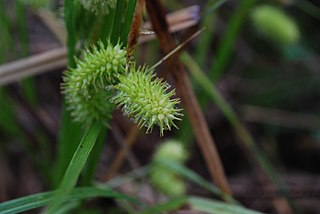
Carex lurida is a tussock-forming flowering plant of the family Cyperaceae, the sedge family. Common names for Carex lurida include shallow sedge, sallow sedge and lurid sedge.
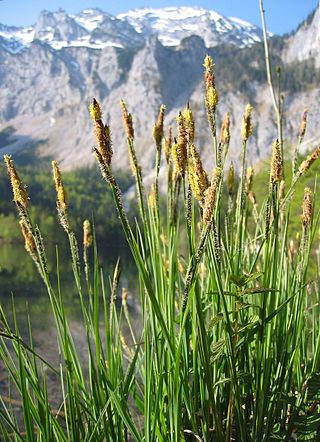
Carex elata, is a species of tussock-forming, grass-like plant in the Cyperaceae family. It is native to all of Europe, the Atlas Mountains of Africa, Turkey, Iran and Central Asia.
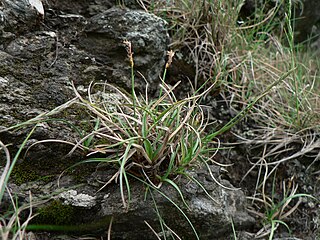
Carex rupestris, called the curly sedge and rock sedge, is a species of flowering plant in the family Cyperaceae, native to temperate and subarctic North America, Greenland, Iceland, Europe, and Asia.

Carex pedunculata, the long-stalk sedge or longstalk sedge, is a species of flowering plant in the genus Carex, native to Canada and the central and eastern United States. Its seeds are dispersed by ants.

Carex pilosa, called hairy sedge or wimper sedge is a species of flowering plant in the genus Carex, native to central and eastern Europe as far as the Urals. It is typically found in temperate forests, where it may be the dominant species on the forest floor.
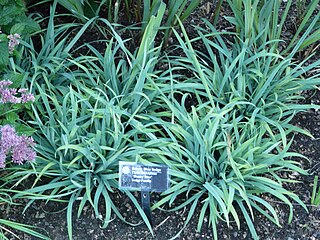
Carex laxiculmis, the creeping sedge, is a species of flowering plant in the family Cyperaceae, native to Ontario, Canada, and the central and eastern United States. As with most species of sedge, it prefers to grow in shady, wet areas. Its cultivar 'Hobb', sold under the trade designation Bunny Blue, is available from commercial nurseries.
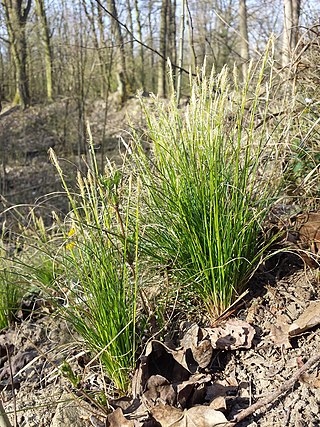
Carex alba, called the small white sedge, white-flowered sedge or just white sedge, is a species of sedge in the family Cyperaceae. It is typically found in temperate forests of Eurasia, from the Pyrenees to the Russian Far East. It is the main host plant for the woodland brown butterfly, Lopinga achine.

Carex retrorsa,, is a widespread species of flowering plant in the family Cyperaceae, native to southern Canada and the northern United States.
Carex idaea is a species of sedge in the family Cyperaceae, native to Crete. It is genetically very close to Carex distans, but has a number of distinct differences, including a higher number of chromosomes, stiffer leaves, and dark red-purple flowers.
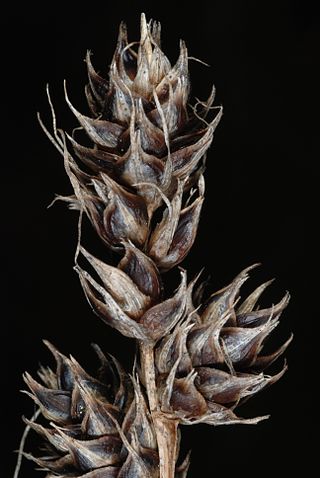
Carex gravida, also known as heavy-fruited sedge, heavy sedge or long-awned bracted sedge, is a tussock-forming species of perennial sedge in the family Cyperaceae. It is native to southern parts of Canada and parts of the United States.
Carex interrupta is a tussock-forming species of perennial sedge in the family Cyperaceae. It is native to south eastern parts of Canada and north eastern parts of the United States.
Carex cephalotes, also known as wire-head sedge, is a tussock-forming species of perennial sedge in the family Cyperaceae. It is native to south eastern Australia and New Zealand.
Carex waponahkikensis, commonly known as the Dawn-land sedge, is a species of sedge first described by M. Lovit and A. Haines in 2012. It is native to a small range in the state of Maine as well as in adjacent parts of coastal New Brunswick.

















